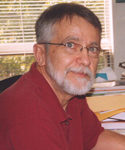 |
A brief
biography of Carmen Chicone
by Yuri Latushkin, University of Missouri, Columbia, MO 65211
and Weishi Liu, University of Kansas, Lawrence, KS 66045 |
| Carmen Chicone. |
Carmen C. Chicone was born 4 March 1946 in
Elmira, New York and grew up in Watkins Glen, New York, the son of
Italian-American immigrants. He earned his undergraduate degree from
the State University of
New York at Albany in 1968 and earned his Ph.D. in mathematics at
the University of
Wisconsin in 1977. After one year as a visiting assistant
professor at the University of Missouri-Columbia, he joined the
faculty in 1978 and has been a Professor of Mathematics since 1989.
Since 2005, he has held an Adjunct Professorship in Veterinary
Pathobiology at the University of Missouri.
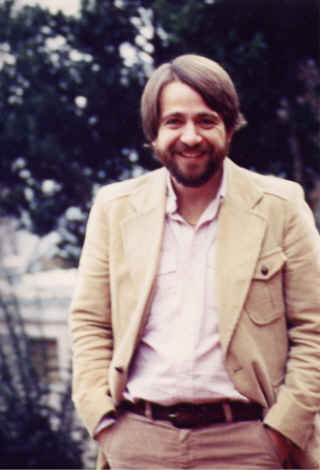 |
|
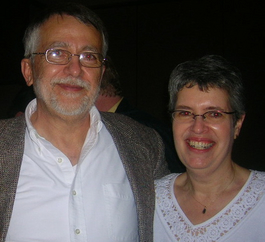 |
| Carmen in the 1980s. |
Carmen and his wife Jenny
Chicone. |
In summer 1985, Carmen visited the
Instituto Nacional the
Matemática Pura e Aplicada in Rio de Janeiro, Brazil, to
collaborate with Jorge Sotomayor, and in the following summer he
visited the Federal
University of Rio de Janeiro, to collaborate with Izabel Camacho.
The winter of 1989 he spent on sabbatical leave at Limburgs
Universitair Centrum (now called Hasselt University) in Hasselt, Belgium, visiting
Freddy Dumortier.
Carmen works in the areas of dynamical systems and
applied mathematics. He has published over 70 research articles and
two books, one of which is co-authored with Yuri Latushkin. During
19-21 May 2006 a
Dynamical Systems Workshop
was held at the
University of Missouri-Columbia in honor of Carmen Chicone's 60th
birthday (see also the report in
DSWeb
Magazine).
Chicone published his first paper [1] in 1979, in which he completely solved the
structural stability problem of quadratic gradients (planar
quadratic polynomial vector fields as gradients of cubic polynomials).
Namely, as the title of the paper says, quadratic gradients on the
plane are generically Morse-Smale. A key ingredient in his proof is a
beautiful result: A connecting orbit between saddles of a quadratic
gradient has to lie on a straight line. This theorem has a nice
application in the study of conservation laws (see Gardner and
Zumbrun [Comm. Pure Appl. Math. 51 (1998), 797-855]).
Furthermore, in [2], Chicone and Douglas Shafer
showed that Morse-Smale quadratic gradients are structurally stable in
the Whitney topology and constructed an example of a structurally
unstable quadratic Morse-Smale vector field.
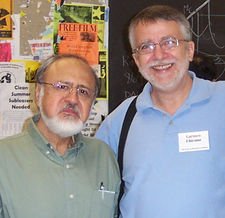 |
|
Since the
celebrated work of Anosov on diffeomorphisms, much research has been
carried out relating to this subject. In a series of works, mainly in
collaboration with Richard Swanson, Chicone examined relationships
between Anosov diffeomorphisms, infinitesimal ergodicity and spectrum
of the adjoint representation of diffeomorphism. For a diffeomorphism
\(f\) of a compact manifold \(M\), a natural adjoint representation is the operator
\(f_{*}: X \to Tf\cdot X\cdot f^{-1}\) on the space
\(\Gamma(TM)\) of continuous sections of the tangent bundle of
\(M\).
|
| Jorge Sotomayor and
Carmen Chicone. |
If \(m\) is a measure on \(M\), one can define the space
\(\Gamma^2(TM)\) of square-integrable sections and the space of
\(H^1(TM)\) sections with one square-integrable weak
derivative. The adjoint representation \(f_*\)
acts on both
\(\Gamma^2(TM)\)
and \(H^1(TM)\). A diffeomorphism \(f\) is said to be infinitesimally ergodic with respect to an
\(f\)-invariant measure \(m\) if
\(I-f_*: H^1(TM) \to H^1(TM)\) has dense range. In their first
joint work [3] Chicone and Swanson disproved a
conjecture by Robbin that every Anosov diffeomorphism is
infinitesimally ergodic. Continuing their work in
[4], they established that the spectra of \(f_*\) on
\(\Gamma(TM)\) and
\(\Gamma^2(TM)\) (with \(m\) being \(f\)-invariant) are identical. As a consequence of a result
of Mather that \(f\) is Anosov if and only if \(f_*\) acting on
\(\Gamma(TM)\) is hyperbolic
[Nederl. Akad. Wetensch. Indag. Math. 30 (1968), 479-483], \(f\) is Anosov if \(f_*\) is hyperbolic on
\(\Gamma^2(TM)\). For a flow \(f^t\) generated by the vector field \(X\), they also established a very deep result -- the spectral
mapping theorem: the spectrum \(f_*^1\) on
\(\Gamma(TM)\) is the exponentiation of the spectrum of \(L_X\) on
\(\Gamma(TM\vert[X])\) where \(L_X\) is the Lie derivative with respect to \(X\). These results have several applications: for example,
the geodesic flow on the unit tangent bundle of a Riemannian manifold
of negative curvature is Anosov ([5]) and, in the
case of constant negative curvature, it is infinitesimally ergodic
([6]).
In collaboration with Paul Ehrlich, Chicone
considered the following interesting question: Given a vector field
\(X\) on a manifold \(M\), when can one find a metric \(g\) (Riemannian or Lorentzian) so that the integral curves of
\(X\) are all geodesics of \(g\)? Their three main results are:
- For a nonsingular vector field \(X\) on a contractible subset \(S\) of
\({\mathbb{R}}^2\), null geodesibility of \(X\) is equivalent to \(X\) being pre-Hamiltonian (i.e., Hamiltonian possibly after
reparametrization) on \(S\);
- Timelike, spacelike or Riemannian pre-geodesibility of \(X\) are all equivalent to \(X\) being gradient-like (i.e., \(X\) has a differentiable Lyapunov function)
([7]);
- A vector field \(X\) is null geodesible if and only if there exists a smooth
one-form \(\omega\) and a smooth line subbundle \(\bf {L}\) of \(TM\) such that
\(\omega(X)=0\),
\(\omega(\bf {L})\neq 0\) at any point, and
\(i_Xd\omega=0\) ([8]).
In a related result ([
9]), Chicone and Ehrlich
generalized results of Gromoll and Meyer
[
Ann. Math. 90 (1969), 75-90] and of Hawking and
Penrose
[
Proc. Roy. Soc. London Ser. A 314 (1970), 529-548]
and proved that if the integral of the Ricci curvature of the tangent
vector field of a complete geodesic in a Riemannian manifold or a
complete nonspacelike geodesic in a Lorentzian manifold is positive,
then the geodesic contains a pair of conjugate points. It seems that
further investigation of the relations between dynamical behavior and
these geometric properties would be an interesting research
project.
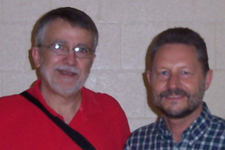 |
|
In the 1980s, Chicone
(collaborating with several researchers) made several important
contributions to the second part of Hilbert's 16th problem. The
problem is to express the number of limit cycles in terms of the
degree of planar polynomial vector fields, and it stimulated a
tremendous amount of research activity. Though simply stated, this
problem turns out to be very difficult: even for quadratic polynomial
vector fields the answer is still unknown.
|
| Carmen Chicone and
Freddy Dumortier. |
One of Chicone's results ([10]
jointly with Douglas Shafer), combined with the results of
Poincaré [J. Mathématiques 7 (1881), 375-422] and
Andronov [Theory of bifurcations of dynamic systems on the plane.
Halsted Press, New York, 1973], provides a partial solution of Dulac's
problem on the finiteness of limit cycles for polynomial vector
fields: If a quadratic system has infinitely many limit cycles, then
the limit cycles have an accumulation point at infinity. Later,
Dulac's problem was completely solved by Ecalle and Il'yashenko (see
Finiteness Theorems for Limit Cycles. Transl. Math.
Monogr., 94. Amer. Math. Soc., Providence, RI,
1991]).
An important problem related to the study of limit
cycles is the understanding of the period functions of centers and the
bifurcation of limit cycles from centers, especially the bifurcation
of limit cycles from isochronous centers (i.e. the corresponding
period function is constant). Inspired by the work of Bautin
[Amer. Math. Soc. Transl. 100 (1954), 1-19], Chicone
and Marc Jacobs considered families of plane analytic vector fields
with \(N\) parameters such that each member of the family has a
center. At an isochronous center in such a family, they construct an
ideal (in the polynomial ring in \(N\) variables) from the Taylor coefficients of the period
function and show that the number of generators of their ideal is the
maximal number of critical points of the period function that can
bifurcate from the isochronous center. These results are applied to
quadratic systems with Bautin centers and to one-degree-of-freedom
`kinetic + potential' Hamiltonian systems with polynomial potentials.
Carmen also obtained other results concerning the monotonicity
([11, 12]) and finiteness of
critical values ([13]) of period functions of
planar vector fields. In related work, Chicone and Jacobs showed that
at most three limit cycles can bifurcate from the harmonic oscillator
\(\dot x=-y\) and \(\dot y=x\) (which has an isochronous center) in a quadratic
family ([14, 15]). This result
is now in textbooks [L. Perko,
Differential Equations and Dynamical Systems, 2nd
Ed., New York, Springer-Verlag, 1996].
One of Chicone's conjectures (which appeared in
Mathematical Reviews MR 94h:58072) has been the subject of several recent
papers; it is still open: If a quadratic system has a center with a
period function that is not monotonic, then, by an affine
transformation and a constant rescaling of time, the system can be
transformed to the Loud normal form
\(\dot x =-y+B xy\),
\(\dot y= x+D x^2 +F y^2\). Moreover, a system in Loud normal
form has a center at the origin with a period function that has at
most two critical points.
Nonlinear oscillation problems have played an
important role in the development of dynamical system theory. In the
1990s, Chicone considered two types of problems:
- continuation of periodic orbits in a family of periodic orbits of
autonomous perturbed oscillations, and
- for periodic perturbed oscillations, the perturbation of
subharmonics from resonant periodic orbits (both isolated and
non-isolated).
For problems of type (1), Chicone applied Lyapunov-Schmidt reduction
to obtain bifurcation functions whose zeros correspond to periodic
orbits that can be continued ([
16,
17,
18,
19]). An important contribution of this work is the
recasting of bifurcation problems in a form where their geometry is
explicitly incorporated. For problems of type (2), Chicone constructed
bifurcation functions whose zeros provide subharmonic orbits via a
generalization of Melnikov's method ([
20,
21]). He applied these techniques in many areas, for
example, in the continuation of periodic orbits of resonantly coupled
oscillators, the synchronization of inductively coupled Van der Pol
oscillators, hydrodynamic instability of steady states of Euler's
hydrodynamic partial differential equation, entrainment domains of
periodically perturbed Van der Pol oscillatiors, and later, a
Keplerian binary system perturbed by periodic gravitational
radiation.
Hyperbolicity plays a central role in
characterizing asymptotic behavior of dynamical systems. For
finite-dimensional dynamical systems, this concept is well
understood. In collaboration with Yuri Latushkin and Stephen
Montgomery-Smith, Chicone investigated this problem for
infinite-dimensional dynamical systems. For a \(C^0\) semi-group
\(\{T_t: t \ge 0\}\) on a Hilbert space \(H\), Chicone and Latushkin found a characterization of the
hyperbolicity of \(T_t\) in terms of the dissipativity of its generator
([22]). This result was obtained via a proper
generalization of the concept of hyperbolicity to an evolution family
\(\{U(t,s): t \ge s\}\) using exponential dichotomy as, for
example, the work of Daleckii and Krein
[Stability of solutions of differential equations in
Banach space, Transl. Math. Monogr., 43. Amer. Math. Soc.,
Providence, RI, 1974]. Extending their work, Chicone and Latushkin
([23]) examined hyperbolicity of linear
skew-product flows of Hilbert bundles (bundles with a Hilbert space
\(H\) as fibers) over a compact metric space \(X\). The hyperbolicity of such a linear skew-product flow is
characterized by the hyperbolicity of a semi-group of weighted
composition operators defined on \(L^2(X,H)\). A quadratic Lyapunov function can be constructed
using the equivalence of hyperbolicity and dissipativity.
Spectral theory for semi-groups generated by
infinite-dimensional dynamical systems is more involved than the
corresponding theory for finite-dimensional systems. One of most
important problems is the validity of the spectral mapping property
that relates the spectrum of the semi-group to the spectrum of its
generator via exponentiation. In finite-dimensional systems the
exponential of the spectrum of the generator is always the spectrum of
the semi-group. Together with Latushkin and Montgomery-Smith
([24]), Chicone examined the spectrum of the
kinematic dynamo operator \(L\) for an ideally conducting fluid on a closed Riemannian
manifold \(X\). One of the difficulties associated with \(L\) is working with a space of divergence-free vector
fields. Inspired by the work of de la Llave
[Geophys. Astrophys. Fluid Dynam. 73 (1993),
123-131], they obtained conditions under which the spectral
mapping theorem holds for
\(\dim X \ge 3\). For
\(\dim X \ge 2\), the spectrum of \(e^{tL}\) for \(t\neq 0\) was shown to be exactly one annulus centered at the
origin, which confirms a conjecture of de la Llave who obtained a
similar result under a more restrictive assumption. Thus, the spectral
mapping theorem implies that the spectrum of \(L\) is a strip containing the purely imaginary
axis. Consequently, the ideally conducting fluid does not have an
exponential dichotomy. The boundary of the spectrum of \(L\) was further characterized via Lyapunov exponents
following previous work of Latushkin and Stëpin
[Uspekhi Mat. Nauk 46(2) (1991), 85-143]. This work
was generalized in [25] where the operator is
generated by an arbitrary vector field \(u\) (not necessarily divergence-free). Another aspect of the
generalization is the consideration of the semi-group on
divergence-free vector fields induced by a general cocycle. In this
setting, they obtained the annular hull theorem: the exponentiation of
the spectrum of the generator and its hull `sandwich' the spectrum of
the semi-group. As a corollary, the spectral radius of the generator
is equal to the bound on the growth of the semi-group. This result is
delicate; it is not true for general semi-groups and their
generators.
Chicone and Latushkin ([26])
also considered the linear differential operator
\(D_\epsilon u=\epsilon\Delta u+{\rm curl}(v\times u)\) on the
unit tangent bundle of a compact surface of constant negative
curvature \(k\), where \(\Delta\) is the Laplacian with respect to the Sasaki metric,
\(v\) the infinitesimal generator of the geodesic flow and
\(\epsilon=1/R_{\rm m}>0\) (\(R_{\rm m}\) denotes the magnetic Reynolds number). This
defines an idealization of the dynamo operator. Let
\(s_\epsilon=\sup\{{\rm Re}\,\lambda\vert\lambda\in\sigma(D_\epsilon)\}\) be the spectral radius of
\(D_\epsilon\). They showed that
\(s_\epsilon>0\) and
\(\limsup_{\epsilon\to0}s_\epsilon>0\) if
\(R_{\rm m}\geq\sqrt{-k}\), and hence, the
associated kinematic dynamo given by
\(\dot u=D_\epsilon u\) and
\({\rm div}\,u=0\), is fast.
Another research direction of Chicone and Latushkin
is their study of center manifolds of mild solutions of semi-linear
nonautonomous differential equations ([27]). The
novelty of this work lies in its generality and direct application of
a Lyapunov-Perron type treatment. An interesting point is that they
formulated the usual gap condition in spectral terms and showed that
this condition is, in fact, a condition on the corresponding spaces of
differentiable functions. This allowed them to obtain a direct proof
of the existence of a smooth global center manifold.
The theory of normally hyperbolic invariant
manifolds is important in the geometric study of global dynamical
systems. An invariant manifold is normally hyperbolic if the
generalized Lyapunov numbers are strictly less than 1. A
fundamental fact is that normally hyperbolic invariant manifolds
persist under \(C^1\) perturbations. In practice, one often wishes to
continue a normally hyperbolic invariant manifold with respect to some
parameter beyond such a perturbation. What property of the underlying
parametrized system allows the continuation of a normally hyperbolic
invariant manifold? A natural guess is that the manifold can be
continued as long as the generalized Lyapunov numbers are uniformly
bounded away from 1. (In fact, this criterion is wrong, but
it has been used by several authors in the early literature on this
subject.) Collaborating with Weishi Liu [28],
Chicone investigated the continuation of resonant periodic orbits of
periodically perturbed systems. As a by-product, they found that the
above condition on the generalized Lyapunov numbers is not sufficient
for continuation of normally hyperbolic invariant manifolds.
An interest in two-body motion in modern physics
(that is, no action at a distance) led Chicone to study approximations
of functional differential equations by Newtonian equations, with
post-Newtonian corrections [29]. Ryabov made an
initiation in the study of delay equations with small delays and,
among others, Driver further investigated the problem
[SIAM Review 10 (1968), 329-341;
J. Differential Equations 21 (1976), 148-166]. Chicone proved for a
smooth delay equation with state variable in
\({\mathbb{R}}^n\) and small delay \(\tau\) that the so-called Ryabov's special solutions form an
\(n\)-dimensional smooth inertial manifold that varies
smoothly with the delay. The reduced dynamical systems on the inertial
manifold can be viewed as an approximation of the full delay equation.
A widely employed different approach of approximating the delay
equation is via a Taylor expansion of the vector field in \(\tau\) at \(\tau=0\). For every \(N\)th-order truncation of this expansion, the corresponding approximation, which is a system of ODEs, has an \(n\)-dimensional slow manifold. In [30,
31], Chicone established that the reduced vector
fields on the \(n\)-dimensional inertial manifold and the \(n\)-dimensional slow manifold agree up to order \(N-1\). This result provides a justification of the Taylor
expansion approximation method.
Chicone has devoted serious efforts to various
applied aspects of dynamical systems in collaborating with researchers
from other disciplines. The dynamics of continuous stirred tank
reactors has many engineering and industrial applications. For
example, continuous stirred tank reactors are widely used in labs to
help design waste water treatment. With collaborators
([32, 33,
34, 35]), Chicone applied
bifurcation and singularity theory to provide concrete results on
maximal multiplicity of critical points for various models
corresponding to several different physical situations. Early studies
on critical points had been conducted by Dangelmayr and Stewart
[SIAM J. Math. Anal. 15 (1984), 423-445;
SIAM J. Appl. Math. 45 (1985), 895-918] and by
Golubitsky and Keyfitz
[SIAM J. Math. Anal. 11 (1980), 316-339]. Chicone and
his collaborators further analyzed the dynamical behavior including
the stability of critical points, existence of a circulatory
attractor, and the route to chaos ([36]). With
Latushkin and David Retzloff ([37]) he considered
the dynamical behavior of certain tubular flow reactors. The
mathematical models taken are coupled reaction-diffusion equations on
a bounded interval. They established existence and persistence of
multiple steady states with parameters. Most interestingly, the
stability of steady states is completely determined: two special
steady states corresponding to maximal and minimal energy are
(locally) stable, and all others are unstable.
During the period 1996-2000, teamed with physicist
Bahram Mashhoon and chemical engineer David Retzloff at MU, Chicone
investigated global and long-term dynamical behavior of a Keplerian
binary system perturbed by periodic gravitational radiation.
Mathematically, the system is a periodically perturbed Hamiltonian
system with all physical terms specified. They examined several
important issues, including the existence of periodic orbits
([38, 39]), resonance capture
followed by sustained resonance ([40,
41]), and chaotic behavior ([42,
43]). The mathematical analysis involves a large
body of the theory of dynamical systems: KAM theory, the method of
averaging, invariant manifolds, Melnikov method, etc. This work is a
seminal example of applying mathematical theory in physical
problems.
Most recently, in a series papers
[44, 45, 46,
47, 48, 49,
50] co-authored with Mashhon, Chicone investigated
the tidal and inertial effects of ultrarelativistic motion. Through
their careful analysis they discovered, contrary to Newtonian
expectations, that if the relative speed of free relativistic
particles exceeds the critical value
\(c/\sqrt{2}\) where \(c\) is the speed of the light, then the first-order
gravitational tidal effects cause an acceleration (resp. deceleration)
of the ultrarelativistic particles in the swarm moving in directions
normal (resp. parallel) to the jet direction. Their results suggest a
black hole tidal acceleration mechanism that could be relevant to the
creation of highly energetic particles by micro-quasars in our galaxy
as well as the origin of the highest energy cosmic rays reaching the
Earth.
|
Carmen is currently
working with his graduate students on several research projects:
modeling and optimization in cryobiology, minimal distortion
transformations in elasticity, a two-body problem in acoustics, and
Hertzian contact impact oscillators. In addition, he is writing a new
book with working title An Invitation to Applied
Mathematics.
|
|
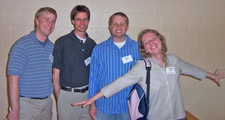 |
| Chicone's current
PhD students James Benson, Michael Heitzman, Kenneth Felts, and Oksana
Bihun. |
Finally, on a personal note, both Yuri and Weishi
have had very pleasant collaborations with Carmen and they cherish
their friendship with him.
Bibliography
| 1. |
C. Chicone, ``Quadratic gradients on
the plane are generically Morse-Smale.''
J. Differential Equations 33 (1979), 159-166. |
| 2. |
C. Chicone and D. S. Shafer,
``Quadratic Morse-Smale vector fields which are not structurally stable.''
Proc. Amer. Math. Soc. 85 (1982), 125-134. |
| 3. |
R. C. Swanson and C. Chicone,
``Anosov does not imply infinitesimally ergodic.''
Proc. Amer. Math. Soc. 75 (1979), 169-170. |
| 4. |
C. Chicone and R. C. Swanson,
``The spectrum of the adjoint representation and the hyperbolicity of
dynamical systems.''
J. Differential Equations 36 (1980), 28-39. |
| 5. |
C. Chicone and R. C. Swanson,
``Infinitesimal hyperbolicity implies hyperbolicity.''
Global theory of dynamical systems (Proc. Internat. Conf.,
Northwestern Univ., Evanston, Ill., 1979), pp. 50-64,
Lecture Notes in Math., 819,
Springer, Berlin-New York, 1980. |
| 6. |
C. Chicone,
``Tangent bundle connections and the geodesic flow.''
Rocky Mountain J. Math. 11 (1981), 305-317. |
| 7. |
C. Chicone and P. Ehrlich,
``Gradient-like and integrable vector fields on \(R\sp 2\).''
Manuscripta Math. 49 (1984), 141-164. |
| 8. |
C. Chicone and P. Ehrlich,
``Lorentzian geodesibility.''
Differential topology-geometry and related fields, and their
applications to the physical sciences and engineering, 75-99,
Teubner-Texte Math., 76, Teubner, Leipzig, 1985. |
| 9. |
C. Chicone and P. Ehrlich,
``Line integration of Ricci curvature and conjugate points in
Lorentzian and Riemannian manifolds.''
Manuscripta Math. 31 (1980), 297-316. |
| 10. |
C. Chicone and D. S. Shafer,
``Separatrix and limit cycles of quadratic systems and Dulac's
theorem.''
Trans. Amer. Math. Soc. 278 (1983), 585-612. |
| 11. |
C. Chicone,
``The monotonicity of the period function for planar Hamiltonian
vector fields.''
J. Differential Equations 69 (1987), 310-321. |
| 12. |
C. Chicone and F. Dumortier,
``A quadratic system with a nonmonotonic period function.''
Proc. Amer. Math. Soc. 102 (1988), 706-710. |
| 13. |
C. Chicone and F. Dumortier,
``Finiteness for critical periods of planar analytic vector fields.''
Nonlinear Anal. 20 (1993), 315-335. |
| 14. |
C. Chicone and M. Jacobs,
``Bifurcation of critical periods for plane vector fields.''
Trans. Amer. Math. Soc. 312 (1989), 433-486. |
| 15. |
C. Chicone and M. Jacobs,
``Bifurcation of limit cycles from quadratic isochrones.''
J. Differential Equations 91 (1991), 268-326. |
| 16. |
C. Chicone,
``Lyapunov-Schmidt reduction and Melnikov integrals for bifurcation of
periodic solutions in coupled oscillators.''
J. Differential Equations 112 (1994), 407-447. |
| 17. |
C. Chicone,
``A geometric approach to regular perturbation theory with an
application to hydrodynamics.''
Trans. Amer. Math. Soc. 347 (1995), 4559-4598. |
| 18. |
C. Chicone,
``Periodic solutions of a system of coupled oscillators near
resonance.''
SIAM J. Math. Anal. 26 (1995), 1257-1283. |
| 19. |
C. Chicone,
``Periodic orbits of coupled oscillators near resonance.''
Planar nonlinear dynamical systems (Delft, 1995).
Differential Equations Dynam. Systems 5 (1997),
203-227. |
| 20. |
C. Chicone,
``Bifurcations of nonlinear oscillations and frequency entrainment
near resonance.''
SIAM J. Math. Anal. 23 (1992), 1577-1608. |
| 21. |
M.B.H. Rhouma and C. Chicone,
``On the continuation of periodic orbits.''
Methods Appl. Anal. 7 (2000), 85-104. |
| 22. |
C. Chicone and Y. Latushkin,
``Hyperbolicity and dissipativity.''
Evolution equations (Baton Rouge, LA, 1992), 95-106,
Lecture Notes in Pure and Appl. Math., 168,
Dekker, New York, 1995. |
| 23. |
C. Chicone and Y. Latushkin,
``Quadratic Lyapunov functions for linear skew-product flows and
weighted composition operators.''
Differential Integral Equations 8 (1995),
289-307. |
| 24. |
C. Chicone, Y. Latushkin, and
S. Montgomery-Smith,
``The spectrum of the kinematic dynamo operator for an ideally
conducting fluid.''
Comm. Math. Phys. 173 (1995), 379-400. |
| 25. |
C. Chicone, Y. Latushkin, and
S. Montgomery-Smith,
``The annular hull theorems for the kinematic dynamo operator for an
ideally conducting fluid.''
Indiana Univ. Math. J. 45 (1996), 361-379. |
| 26. |
C. Chicone and Y. Latushkin,
``The geodesic flow generates a fast dynamo: an elementary proof.''
Proc. Amer. Math. Soc. 125 (1997), 3391-3396. |
| 27. |
C. Chicone and Y. Latushkin,
``Center manifolds for infinite-dimensional nonautonomous differential
equations.''
J. Differential Equations 141 (1997), 356-399. |
| 28. |
C. Chicone and W. Liu,
``On the continuation of an invariant torus in a family with rapid
oscillations.''
SIAM J. Math. Anal. 31 (1999-2000), 386-415. |
| 29. |
C. Chicone,
``What are the equations of motion of classical physics?''
Can. Appl. Math. Q. 10 (2002), 15-32. |
| 30. |
C. Chicone,
``Inertial and slow manifolds for delay equations with small delays.''
J. Differential Equations 190 (2003), 364-406. |
| 31. |
C. Chicone,
``Inertial flows, slow flows, and combinatorial identities for delay
equations.''
J. Dynam. Differential Equations 16 (2004),
805-831. |
| 32. |
C. Chicone and D. G. Retzloff,
``Dynamics of the CR equations modeling a constant flow stirred tank
reactor.''
Nonlinear Anal. 6 (1982), 983-1000. |
| 33. |
D. G. Retzloff, P. C.-H. Chan,
R. Mohamed, D. Offin, and C. Chicone,
``Maximal multiplicity of the critical points of the CR equation
modeling a constant flow stirred tank reactor.''
J. Math. Anal. Appl. 124 (1987), 327-338. |
| 34. |
D. G. Retzloff, P. C.-H. Chan,
C. Chicone, and I. Papick,
``Maximal multiplicity for sequential bifurcations of a first-order
reaction occurring in continuous stirred tank reactors coupled in
series.''
SIAM J. Appl. Math. 52 (1992), 1136-1147. |
| 35. |
D. G. Retzloff, C. Chicone, and
G.-H. Hsu,
``Multiple solutions of a nonlinear boundary value problem with
application to chemical reactor dynamics.''
J. Math. Anal. Appl. 185 (1994), 501-519. |
| 36. |
D. G. Retzloff, P. C.-H. Chan,
C. Chicone, D. Offin, and R. Mohamed,
``Chaotic behavior in the dynamical system of a continuous stirred
tank reactor.''
Phys. D 25 (1987), 131-154. |
| 37. |
C. Chicone, Y. Latushkin, and
D.G. Retzloff,
``Chemical reactor dynamics: stability of steady states.''
Math. Methods Appl. Sci. 19 (1996), 381-400. |
| 38. |
C. Chicone, B. Mashhoon, and
D.G. Retzloff,
``Gravitational ionization: periodic orbits of binary systems
perturbed by gravitational radiation.''
Ann. Inst. H. Poincaré Phys. Théor. 64
(1996), 87-125. |
| 39. |
C. Chicone, B. Mashhoon, and
D.G. Retzloff,
``On the ionization of a Keplerian binary system by periodic
gravitational radiation.''
J. Math. Phys. 37 (1996), 3997-4016. |
| 40. |
C. Chicone, B. Mashhoon, and
D.G. Retzloff,
``Evolutionary dynamics while trapped in resonance: a Keplerian binary
system perturbed by gravitational radiation.''
Classical Quantum Gravity 14 (1997), 1831-1850. |
| 41. |
C. Chicone, B. Mashhoon, and
D.G. Retzloff,
``Sustained resonance: a binary system perturbed by gravitational
radiation.''
J. Phys. A 33 (2000), 513-530. |
| 42. |
C. Chicone, B. Mashhoon, and
D.G. Retzloff,
``Chaos in the Kepler system.''
Classical Quantum Gravity 16 (1999), 507-527. |
| 43. |
C. Chicone, B. Mashhoon,
D.G. Retzloff,
``Chaos in the Hill system.''
Helv. Phys. Acta 72 (1999), 123-157. |
| 44. |
C. Chicone and B. Mashhoon,
``A gravitational mechanism for the acceleration of ultrarelativistic
particles. ''
Ann. Phys. (8) 14 (2005), 751-763. |
| 45. |
C. Chicone and B. Mashhoon,
``Tidal dynamics of relativistic flows near black holes.''
Ann. Phys. (8) 14 (2005), 290-308. |
| 46. |
C. Chicone and B. Mashhoon,
``Ultrarelativistic motion: inertial and tidal effects in Fermi
coordinates.''
Classical Quantum Gravity 22 (2005), 195-205. |
| 47. |
C. Chicone and B. Mashhoon,
``Significance of \(c/\sqrt 2\) in relativistic physics.''
Classical Quantum Gravity 21 (2004), L139-L144. |
| 48. |
C. Chicone and B. Mashhoon,
``The generalized Jacobi equation.''
Classical Quantum Gravity 19 (2002), 4231-4248. |
| 49. |
C. Chicone and B. Mashhoon,
``Acceleration-induced nonlocality: uniqueness of the kernel.''
Phys. Lett. A 298 (2002), 229-235. |
| 50. |
C. Chicone and B. Mashhoon,
``Acceleration-induced nonlocality: kinetic memory versus dynamic
memory.''
Ann. Phys. (8) 11 (2002), 309-332. |